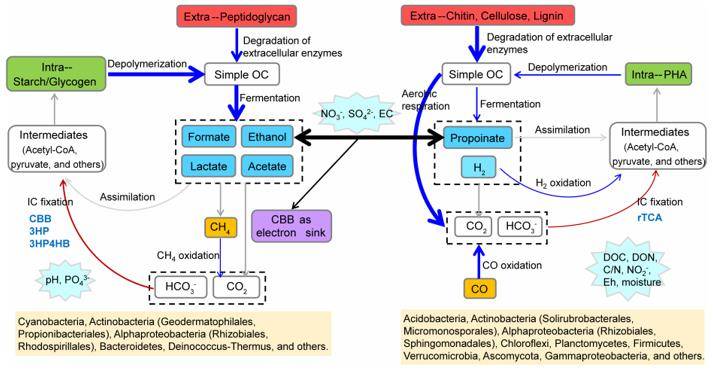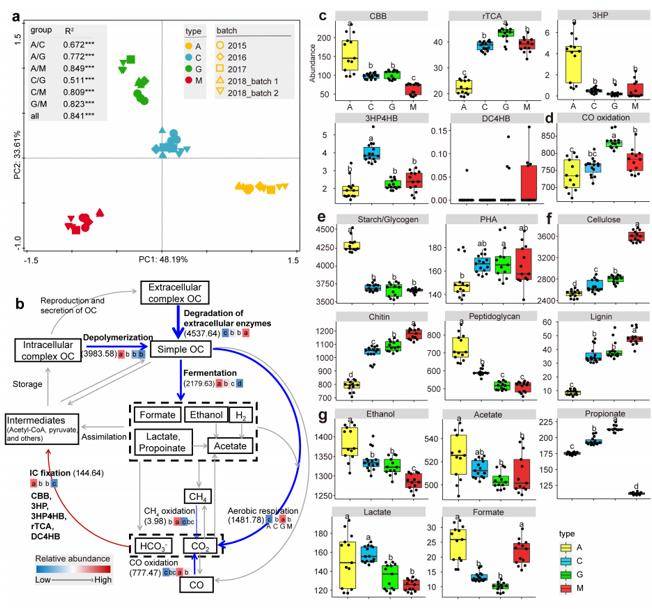What is Microbial Carbon Cycle?
The Earth boasts a staggering annual production of over 5 × 10^9 tons of plant residues, primarily composed of polymers like cellulose, hemicellulose, polysaccharides, and lignin. The decomposition of these organic remnants constitutes a vital cog in the organic carbon balance, particularly in Soil Organic Carbon (SOC), within terrestrial ecosystems. SOC represents the most substantial carbon pool on Earth's surface, making even minor fluctuations impactful not just on community composition and functionality but also on greenhouse gas emissions, including CO2 and CH4, and consequent global climate dynamics. The global soil, to a depth of 1 meter, holds an estimated double the amount of SOC (~1550 Pg) compared to the atmospheric carbon pool (~708 Pg). Consequently, even slight variations in global soil carbon reserves can significantly influence atmospheric carbon dioxide (CO2) concentrations and, by extension, climate change. Central to this complex scenario is the microbial decomposition of soil organic carbon, an integral part of the global carbon cycle, influencing carbon storage and release processes, and holding a pivotal role in carbon equilibrium maintenance. The study of microbial carbon degradation processes in soils offers solutions for improved soil organic carbon management, enhanced soil carbon stocks, and the mitigation of climate change by reducing carbon dioxide emissions. Notably, microbial carbon degradation processes aren't confined to soil media alone; they extend to water bodies, sediments, landfills, in vivo plant processes, and the intricate environments of human and animal intestinal tracts.
 Microbial carbon cycle. (Wang et al., 2022)
Microbial carbon cycle. (Wang et al., 2022)
Carbon Degradation Gene Mining Analysis by Metagenome Sequencing
With the rapid development of high-throughput sequencing technology, researchers can now comprehensively explore carbon degradation genes, utilizing methods such as metagenomics. This technology is rapidly expanding our understanding of the carbon cycle and ecosystem dynamics.
- Characterizing Carbon Degradation Genes: Scientists can now delve into environmental samples to unravel the distribution, diversity, and function of carbon degradation genes in ecosystems, shedding light on their impact on ecosystem stability and the carbon cycle.
- Discovering Uncultured Microorganisms: The technology facilitates the discovery of uncultured microorganisms with potential carbon degradation functions from diverse environments, deepening our comprehension of the carbon cycle and ecosystems.
- Elucidating Metabolic Pathways: Researchers can now explore the carbon degradation metabolic pathways of microorganisms, unveiling the degradation mechanisms and regulation of various organic compounds.
- Understanding Gene Regulation: Studying the regulatory mechanisms of carbon degradation genes in conjunction with multi-omics approaches offers insight into the expression patterns and regulatory mechanisms of these genes, illuminating the relationship between gene regulation and the microbial degradation of different organic compounds.
- Assessing Microbial Communities: The technology provides a platform for studying the carbon degradation potential of microbial communities, offering a theoretical foundation for the development of biodegradable enzymes.
Case Study: Progress in Understanding Carbon Cycling Mechanisms in Microbial Communities
Carbon cycling, a paramount biogeochemical process in soil ecosystems, remains a complex puzzle at the community level. Biological crusts serve as remarkable model systems for biogeochemical cycling research and ecosystem engineering. While techniques can predict material cycling processes via gene abundance, the study of soil microorganisms, responsible for driving carbon transformations, has been challenging due to factors such as microbial physiological status, the structural complexity of soil organic matter, and variations in organic carbon redox status.
In a groundbreaking study, researchers sampled five batches of biological crusts, each at different stages of succession, over four consecutive years at a typical field site. The findings, drawn from a range of metagenomic techniques and big data modeling analysis tools, unveiled the microbial carbon cycling patterns in biological crust communities and their interactions and regulatory mechanisms.
 Carbon cycling based on metagenomic sequencing. (Wang et al., 2022)
Carbon cycling based on metagenomic sequencing. (Wang et al., 2022)
The results highlighted that energy-consuming light energy-driven inorganic carbon fixation genes were scarce, while genes associated with energy-efficient organic carbon degradation, fermentation, aerobic respiration, and CO oxidation were abundant. Co-occurrence analyses further revealed that carbon cycling in biocrust ecosystems encompasses both an assimilation module akin to primary production and an allochthonous module similar to secondary production. The relationship between cycling pathways and microbial community composition dynamically shifts with succession, and both modules are interlinked through the CBB cycle, ethanol, and propionic acid fermentation, balanced by aridity and salinity.
In summary, this study signifies a giant leap in understanding the intricate world of carbon cycling at the microbial community level, offering a promising path toward better stewardship of our ecosystems.
Reference:
- Wang, Qiong, et al. "Carbon cycle in the microbial ecosystems of biological soil crusts." Soil Biology and Biochemistry 171 (2022): 108729.
For research purposes only, not intended for clinical diagnosis, treatment, or individual health assessments.


 Sample Submission Guidelines
Sample Submission Guidelines
 Microbial carbon cycle. (Wang et al., 2022)
Microbial carbon cycle. (Wang et al., 2022) Carbon cycling based on metagenomic sequencing. (Wang et al., 2022)
Carbon cycling based on metagenomic sequencing. (Wang et al., 2022)